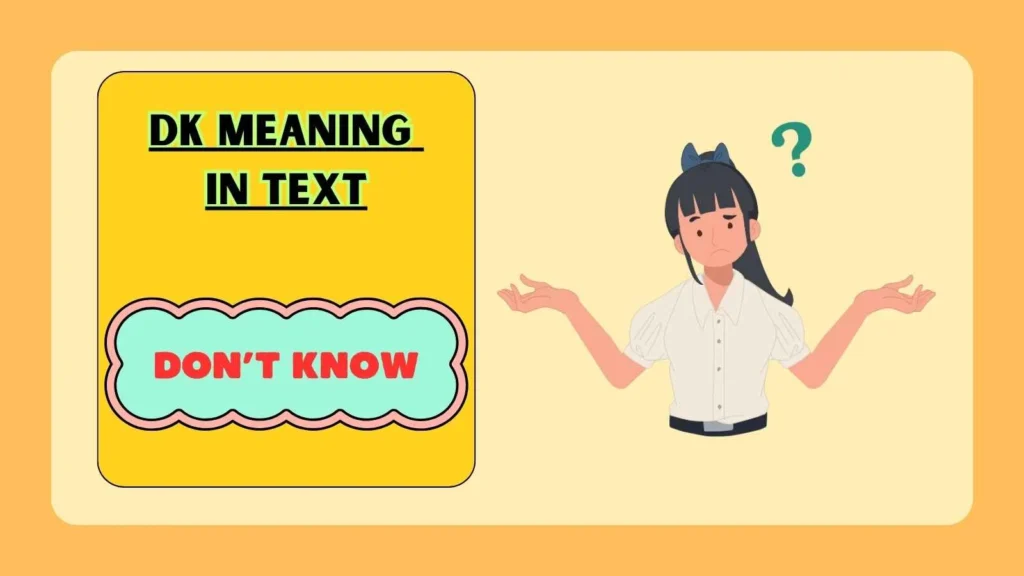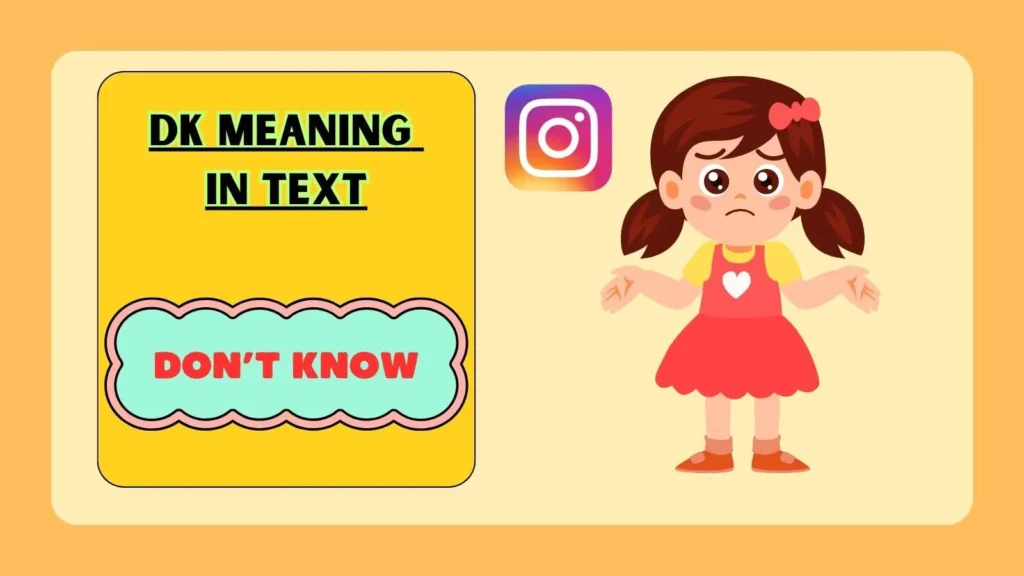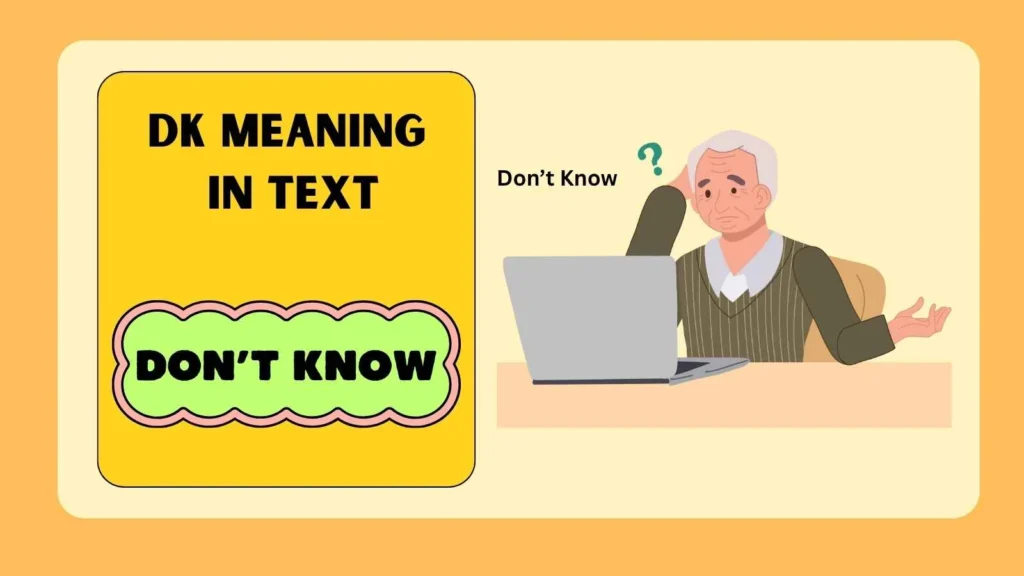Last updated on November 2nd, 2025 at 10:26 pm
Ever wondered what DK Meaning in Text really is? If you’ve been scrolling through messages or social media and stumbled upon “DK,” you’re not alone.
This popular, trending, and viral acronym has left many curious, confused, and eager to decode its true meaning.
Whether you’re texting a friend, chatting online, or exploring slang, understanding DK can make your conversations sharper and more engaging.
Discover the hidden, fun, and unexpected meanings behind DK and never miss a beat in your digital chats again.
Definition & Meaning
In text messaging, DK commonly stands for “Don’t Know”. It is used when someone is unsure about an answer, opinion, or situation. For example:
- “What time is the meeting?”
- “DK, I’ll ask and let you know.”
This abbreviation is favored for its brevity, allowing users to respond quickly without typing long sentences. While “don’t know” is the primary meaning, context matters, as DK can occasionally take on different interpretations depending on the conversation.
Background & History
The use of acronyms in digital communication dates back to the early days of SMS texting in the 1990s. Limited character counts encouraged people to shorten words and phrases. Over time,
DK became a widely recognized shorthand among teens, social media users, and online communities. Its simplicity made it appealing in instant messaging, forums, and mobile apps, where speed and efficiency are key.
Usage in Various Contexts
DK is versatile and can appear in multiple scenarios:
- Casual texting: “DK what to wear tonight.”
- Social media comments: “DK how this trend started.”
- Group chats: Used to express uncertainty without over-explaining.
Its brevity makes it suitable for quick conversations, but context ensures that the recipient understands the intent correctly.
Common Misconceptions & Clarifications
Some people confuse DK with other acronyms or assume it has negative connotations. A few common misunderstandings include:
- Thinking it means “Don’t Care” – this is incorrect; DK generally implies uncertainty, not indifference.
- Confusing it with initials of a person’s name, e.g., DK as “David King” or “Donna Kelly” – context usually clarifies the intended meaning.
Understanding the environment and tone of the conversation is crucial to avoiding misinterpretation.
Similar Terms & Alternatives
Several acronyms and phrases can serve as alternatives to DK, depending on tone and context:
- IDK – “I don’t know” (more common than DK)
- Unsure – casual and informal
- Not sure – slightly longer, polite alternative
Choosing the right abbreviation ensures clarity while maintaining brevity in conversation.
How to Respond to This Term
When someone texts DK, your response may vary:
- Provide information if possible: “It’s at 5 PM.”
- Offer reassurance: “No worries, I’ll check.”
- Acknowledge uncertainty: “Got it, thanks for letting me know.”
Responses should match the tone of the conversation while respecting the sender’s brevity.
Regional or Cultural Differences
While DK is globally recognized in English-speaking online communities, its usage may vary by region. Some non-English speakers might misinterpret or translate it differently.
In texting-heavy cultures, abbreviations like DK and IDK are more prevalent, whereas others may prefer full expressions.
Comparison with Similar Terms
DK vs IDK:
- DK is slightly shorter and less formal.
- IDK is more widely recognized in texting apps and social media.
- DK may appear in faster, casual chats where users prioritize typing speed.
This comparison helps users choose the abbreviation that fits the conversation style best.
Usage in Online Communities & Dating Apps
In online platforms and dating apps, DK is often used to express uncertainty without sounding disinterested. Examples:
- Dating app chat: “Where should we meet? DK, you decide.”
- Gaming communities: “DK which strategy to pick next.”
It is appreciated for its neutral tone, making interactions smoother and less awkward.
Hidden or Offensive Meanings
Generally, DK is harmless and neutral. However, in rare cases, someone may misinterpret it as dismissive. Always consider tone, context, and relationship with the sender before assuming any negative intent.
Suitability for Professional Communication
While DK is acceptable in casual messaging, it is usually not recommended in professional emails or formal communication.
Writing “I don’t know” in full is more professional and ensures clarity. Overusing abbreviations can appear careless in workplace contexts.
💁♀️ What Does DK Mean From a Girl

- 💬 “DK” usually means “Don’t Know,” a casual way of showing uncertainty.
- 😅 Girls often use it when they’re unsure but don’t want to sound too serious.
- 💡 It helps keep the conversation light and friendly instead of awkward.
- 💞 Sometimes, “DK” softens an answer that could otherwise seem blunt.
- 🧠 It can show hesitation — like she’s thinking but hasn’t decided yet.
- ✨ In flirty chats, it may signal shyness or playful confusion.
- 💬 “DK” avoids pressure when a girl doesn’t want to answer directly.
- 🔄 It’s a quick response that keeps texting natural and flowing.
- 💬 Context matters — tone and emojis reveal if it’s casual or teasing.
- 🌈 Overall, it means she’s engaged but relaxed in the conversation.
👦 DK Meaning in Text From a Guy
- 💬 For guys, “DK” almost always means “Don’t Know.”
- 😎 It’s a chill, low-effort reply to keep things casual.
- ⚡ Many guys use it to sound laid-back or uninterested.
- 💭 It can also mean they genuinely have no idea.
- 😂 Often used when they want to avoid over-explaining something.
- 🤔 Sometimes it reflects indecision or not wanting to take sides.
- 💬 “DK” in a chat can mean he’s not sure but still wants to reply quickly.
- 🧩 Add emojis or tone clues to understand if it’s serious or playful.
- 💡 It saves time while keeping the vibe short and cool.
- 🚀 Ultimately, “DK” = “Don’t know” — simple, modern, and effortless.
📱 DK Meaning in Instagram

- 📸 On Instagram, “DK” usually stands for “Don’t Know” in captions or comments.
- 💬 It’s used when users can’t decide or are being funny about something.
- 😅 In stories or DMs, it adds casual uncertainty to replies.
- 💡 Influencers might use “DK” to sound relatable or spontaneous.
- 🧠 It keeps content short, fitting perfectly with fast scrolling culture.
- 🔄 Sometimes, “DK” is shorthand for “Danish Kroner” in price tags.
- 💬 Hashtags like #idk or #dk often appear together for clarity.
- ✨ Emojis next to “DK” usually reveal tone — funny, confused, or chill.
- 📲 It’s common in memes, polls, and question stickers.
- 🌈 Overall, “DK” helps users sound real, witty, and approachable online.
🌍 DK Means Which Country
- 🇩🇰 “DK” is the country code for Denmark — short and official.
- 🗺️ It appears in internet domains like .dk for Danish websites.
- 💰 On currency labels, “DKK” stands for Danish Krone.
- 🏰 Denmark’s “DK” code comes from “Danmark,” its native name.
- 🌏 Used worldwide in travel, logistics, and global shipping.
- 🧭 Airline codes and license plates also use DK for Denmark.
- ⚡ Social media handles sometimes use “DK” for Danish identity.
- 💡 It’s helpful to know so you don’t mix it up with texting slang.
- 🌐 In databases or forms, “DK” identifies Denmark officially.
- ✨ So, while “DK” means “Don’t Know” in chat, globally it means Denmark.
FAQs
What does DK stand for in texting?
It usually means “Don’t Know.”
Is DK the same as IDK?
Yes, but DK is shorter and less common.
Can DK mean something rude?
Rarely; context matters, but it is generally neutral.
Is DK suitable for work emails?
No, full phrases like “I don’t know” are better.
Where is DK most used?
Texting, social media, online chats, and dating apps.
Can DK be confused with names?
Yes, it can refer to initials, but context clarifies meaning.
Conclusion
Understanding dk meaning in text is crucial for modern communication. Short, simple, and effective, it allows users to express uncertainty quickly without typing long explanations.
While versatile in casual chats, social media, and online communities, DK should be used thoughtfully in professional contexts to avoid misinterpretation.
By knowing its meaning, alternatives, and proper usage, you can communicate clearly, efficiently, and confidently across digital platforms.
